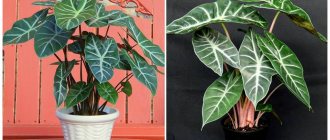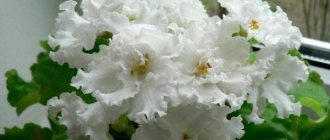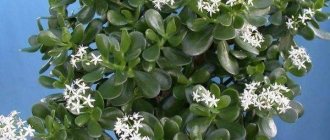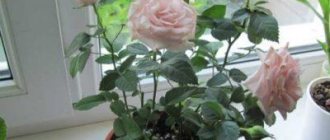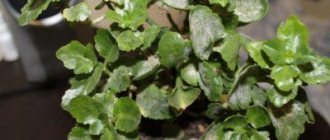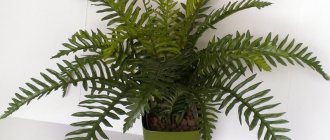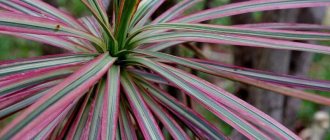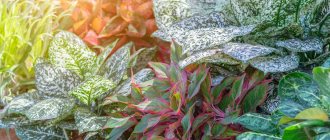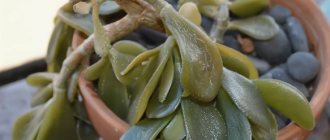People far from floristry know Crassula exclusively as money tree or crassula. Meanwhile, a colossal number of varieties and varieties of plants are grown at home. Flower growers place a tropical plant on the windowsill and perceive it as a talisman to attract finance. And the evergreen leaves, reminiscent of glossy coins, turn the fat plant into a real interior decoration. For the “green talisman” to work and please the eye, no special effort is required. The main thing is to create a suitable microclimate. And we'll tell you how to do it.
Briefly about care
- Watering. Moderate: twice a week in summer, once every 2 weeks in spring-autumn, once a month in winter.
- Illumination. More than 6 hours of indirect sunlight per day. In the shadows it stretches out and dies. In summer the windows are eastern, in winter - south.
- Air humidity. Doesn't matter. The succulent is not afraid of dry air.
- Temperature conditions. In summer: +20+26С, in winter +16С. At temperatures below +4C it may die.
- Bloom. From 5–10 years. The color, size and shape of flowers depends on the variety.
- Rest period. October-March.
- Transfer. Once every 2–3 years, in spring.
- Soil mixture. Nutritious, well-drained potting mix for cacti and succulents.
- Fertilizers. Light fertilizing with fertilizers for cacti and succulents (a quarter of the dose stated by the manufacturer). No more than once every 2 weeks during the growing season.
- Reproduction. Seeds, leaves, cuttings, dividing bushes.
- Diseases. Root rot, fungi (from waterlogging).
- Pests. Mealybug, spider mite, scale insects.
Diseases and pests of Crassula ovata "Hobbit" and "Gollum"
Succulents often suffer from fungal diseases, the cause of which is excessive watering. The first sign of rot is that the leaves shrivel and Crassula 'The Hobbit' drops them. You need to adjust the humidification mode. It is advisable to pull the succulent out of the pot and check the roots for rot. If you find a disease, remove the infected roots and replant the tree in fresh soil and a pot.
Mealybugs may appear during primary flowering. They usually hide under the leaves or stem, to remove them, use a spray bottle or dampen any soft cloth with alcohol and smoothly wipe these insects off. Use this procedure a couple of times - this will help get rid of their offspring.
General information about the plant
Crassula is unpretentious and caring for it at home does not require any special effort. Regardless of the variety, the algorithm of actions and conditions of detention are unchanged.
In nature, the evergreen crassula (Latin crassula - thick) amazes with its diversity of species. The vast majority of plants belong to the succulent family Crassulaceae, numbering over 360 species.
Semi-tree, bush and herbaceous larches can be found in the driest parts of our planet. There are especially many Crassulas in South African savannas and woodlands.
The more complex the living conditions, the more decorative the appearance, the brighter the color and the more intricate the flowers.
In terms of external characteristics and structural features, the Crassula varieties differ greatly from each other. Only a few features unite all species and varieties of the Tolstyankov family:
- opposite arrangement of leaves (each pair of leaves is at an angle of 90 degrees relative to the previous one);
- absence of dissection;
- small flowers of different shades are collected in inflorescences with the same number of stamens and petals;
- the root system is shallow.
Carefully! Crassula is poisonous. The juice of the leaves of the plant contains arsenic.
Money tree in all its simplicity
Crassula oval, Crassula ovata, Crassula ovata, monkey tree or money tree (Crassula ovata) are the most common type of indoor succulents. For many lovers, plants appear as a mythical “magnet” for financial well-being and prosperity, but the energetic, and especially the magical talents of plants are in the category of rumors and speculation. Crassula oval would never have become such a popular crop if not for its purely practical and decorative advantages over its competitors.
Crassula oval is an evergreen, durable succulent shrub with gradually woody shoots. Its height depends on the method of formation and can either be limited to 20 cm or exceed 70 cm. The stems with an unusual light, grayish-brown bark gradually become woody. Young shoots are thick, fleshy, round, the same color as the leaves. The ease of formation allows Crassula ovata to be grown in the form of a single- or multi-stemmed tree, bush, or even in the form of a bonsai, which allows Crassula ovata to remain on the list of fashionable and modern plants.
The oval-ovate opposite leaves of Crassula ovata are easily recognized by their fleshiness, thick petioles, their special texture and rich light color. If you look closely, you will notice that each pair of leaves is rotated 90 degrees relative to the previous one. Waxy, shiny and very decorative, with a reddish tinge along the edges that appears depending on the light, the leaves of Crassula oval appear almost flawless and fresh. The presence of short aerial roots under the leaves adds a special charm to this type of Crassula.
The fragility and brittleness of the shoots and leaves of Crassula oval often turns into an unpleasant surprise. Careless handling, negligence, placement in a place where the plant is accidentally touched lead to permanent injuries, breaking off leaves and shoots. Due to its fragility, the fat woman requires careful selection of a “quiet” remote place where the risk of injury will be minimal.
In indoor conditions, Crassula ovala blooms very rarely, at an advanced age, and only under conditions of cool wintering. In autumn and winter, small star-shaped, light pink flowers in small inflorescences seem strikingly touching.
Crassula oval, or money tree (Crassula ovata)
Crassula species
Not all Crassulas take root at home. If you are thinking about purchasing a plant, turn your attention to the compact and unpretentious representatives of the tree, ground cover or spicate groups. Plants of each group have similar characteristics of structure, flowering, shoots, leaves. However, there are also differences.
We present to your attention the types of Crassula suitable for home floriculture, names and photos for clarity.
Columnar
Deceptive
Crassula deceptive or Deceptor (C. Deceptor) - a silvery-white plant native to the deserts of Namibia and South Africa. The miniature succulent is distinguished by a tetrahedral columnar stem reaching a height of 7 cm. Externally, the deceptive Crassula resembles a neat column with a diameter of 2.5 cm. Fleshy gray-green leaves with a whitish coating are tightly pressed to one another. Small pinkish flowers exude a sweet aroma. The deceptive Crassula grows quickly and after a few years takes on an unkempt appearance. The situation can be improved by cutting the stem as short as possible. After crossing with Crassula, phylcata forms the green velvet hybrid “Moonglow”.
Crassula deceptor
Buddha Temple
Crassula Buddha's temple (C. Buddas temple) is a hybrid obtained by crossing Crassula perfoliate and pyramidal. Buddha Temple grows up to 15 cm in height and has a tendency to branch. Buddha's flowers are small, pink-red. Has much in common with the green pagoda hybrid.
Crassula Buddha Temple
Plegmatodes
Crassula plegmatodes (C. plegmatodes) - a low columnar shrub that forms grayish-green columns. The leaves are round, thick, intricately folded: pairs of leaflets seem to be folded crosswise.
Crassula plegmatodes
Spring time
Crassula springtime (C. Spring time) - a decorative compact succulent with a tendency to lodging. The leaves are thick, rich green. The diameter of the shoots is from 3 to 4 cm. It blooms with pale lilac flowers.
Crassula spring time
Pomegranate Lotus
Crassula garnet lotus (C. Garnet lotus) has many thick garnet-purple leaves that appear to be covered with frost. Each leaf is tapered towards the edge and stands vertically in a rosette (lotus-shaped). Height and diameter 15 cm. Blooms in large clusters of red flowers.
Crassula garnet lotus
Garland-shaped
Crassula Corymbulosa (C. corymbulosa) is a small succulent with deep red, fused leaves in pairs. The latter sit tightly on low lodging stems. During the flowering period, the shoots grow significantly.
Ailments and their possible causes
- Crassula sheds its leaves - the succulent is watered with too cold water (there is no need to water a heat-loving flower with tap water; use water at room temperature that has been standing for at least a day).
- The leaves began to wither and turn pale - this usually happens due to excessive watering during the dormant period or excessive feeding with mineral fertilizers during the growing season (you should reduce watering and avoid mineral fertilizers for at least 1 month).
- The leaves have darkened and wrinkled - the plant is suffering from insufficient watering.
- Brown spots have appeared on the surface of the leaf blade - a lack of moisture (it is recommended to spray the fat plant with settled water).
- Near the soil itself, the trunk of the fat plant has turned black - root rot has developed and the plant can only be saved by pruning and re-rooting the surviving shoots.
- The stem is elongated - during the dormant period there is too little light or too frequent watering (you need to adjust the frequency of watering, dry the earthen ball and provide sufficient lighting).
- In summer, the leaves lost their elasticity and fleshiness - too little watering (as a solution, in addition to watering, you can spray the above-ground part).
- The foliage began to dry out and crumble - most likely, the succulent is in cold drafts (move the succulent to a protected place).
- Black dots on the leaves are a sign that the fat plant has received a sunburn.
- The leaves are covered with a white coating - there are spider mites, mealybugs, or the succulent is affected by powdery mildew.
Attention! If your Crassula is in poor condition, after eliminating the causes of the disease, support the plant with Elin, Zircon, and Kornevin. Dilute in water according to the instructions and pour the resulting solution over the “patient”.
If the fat woman suddenly began to wither and turn black right before our eyes, most likely she was in too cold a room and froze. Don't rush to panic. It is better to cut off all affected shoots and sprinkle the cut areas with activated carbon. If there is a possibility that the roots will freeze, remove the plant from the soil, inspect it, trim it if necessary, and replant it in a new soil mixture. It would be nice to spray it with Elin.
Possible problems in growing ovata
The main problem that flower growers face is the death of the Crassula due to the bay. In 9 cases out of 10, the plant dies because it is watered too much. Like all succulents, the money tree will survive prolonged drought relatively painlessly, but flooding of the roots almost always leads to rapid death.
Are there diseases and pests?
Fat women almost never suffer from disease. But when dark, weeping, putrefactive spots appear, the sore spot is cut out, sprinkled with crushed coal, and the plant is sprayed with a fungicide solution.
Shoot affected by spider mites
The most dangerous indoor pests are scale insects and spider mites. They are treated with specialized acaricides.
Crassula ovata has become a real favorite for thousands of gardeners around the world. She doesn’t care about drought, the heat is only good for her, and she should water as little as possible. It grows very slowly, but every year it only gets prettier.
Reproduction methods
Crassula propagates in three ways: cuttings, seeds and leaves. Let's consider each method separately.
Most gardeners use growing new specimens from cuttings. It's simple if you follow a clear algorithm:
- Place the cutting in water with the addition of charcoal and wait for the roots to appear.
- Plant the new plant in a pot (diameter 6 cm).
- Compose the soil from equal parts of river sand, turf and leaf soil.
- Place the pot with the new Crassula in a well-lit place with an air temperature of up to 17 C.
- Water once a day.
Few people like to “play” with seeds, so this method of propagation is not very popular. If you have a lot of free time and a strong desire to start with the most difficult ones, try multiplying using the following tips:
- Place the seeds on the surface of the soil mixture (the soil is prepared as for cuttings).
- Sprinkle water from a spray bottle on top.
- Cover lightly with soil.
- Cover with clear plastic wrap.
- Remove the film once a day to allow the soil to breathe and not mold.
- When the first shoots appear, water them once a day.
Propagation by leaves is not used for all varieties of Crassula. Leaves that have roots in places adjacent to the trunk are suitable here. Select a healthy, strong leaf and leave for 48 hours in a warm, dry room. As soon as the leaf wilts, start rooting:
- Pour the growth stimulator solution into a small glass.
- Deepen the leaf 1 cm into it.
- Place the container on a warm, well-lit windowsill.
You can reproduce it differently:
- Place the leaf on the edge of the pot and dig down 2 cm.
- Add crushed red brick to the soil mixture (this will prevent water from stagnating and the leaf rotting). Instead of soil, you can use crushed sphagnum.
- Moisten the soil.
Methods 1 and 3 provide the highest efficiency. Within a month, the cuttings and leaves begin to produce roots.
Popular varieties of ovoid Crassula
Crassula ovata is a type of succulent plant that has its own varieties, of which there are more than 300. Not all of them are planted on windowsills, but only those that are especially popular. They are small in size, so they can be found in offices and entrance halls.
Ovata minor
The variety was bred by breeders. Distinctive features are compact size (about 50 cm) and slow growth. The trunk is erect, from which shoots extend. The leaves are small, 1.5 cm long and 1 cm wide. Variegated. Color – dark green with bright red edging.
If the plant is in a well-lit place, then you can enjoy all the richness of the color. Typically, Crassula Minor is used to create spectacular mini-gardens in residential settings.
Hobbit
A small succulent plant, the height of which is maximum 90 cm, the width of the bush is about 60 cm. The shape of the leaves is unusual - finger-shaped, tubular with concave tips, their length is up to 5 cm.
The color of the leaves can vary from soft green to rich green, the tips always have a red tint, which can be intensified by exposure to sunlight and low temperatures.
Ovata sunset
A variegated variety of Crassula ovata. This is a compact tree with a lush crown. The leaves are colored in several tones. In the middle - green, closer to the edges - creamy yellow.
In order for the plant to look as decorative as possible and be able to reveal all its flowering characteristics, it must be located in a well-lit place.
Gollum
The plant appeared by mixing Crassula Ovata and Milk. The leaves are in the form of an oblong tube, with expansion noted at the apex. Because of this shape, the leaves are called “Shrek ears.” Their color is green, with a purple rim along the edge.
Crassula Gollum grows very slowly, even in adulthood the maximum height is 50 cm.
The flower is often used to create bonsai. This is because the plant is compact and capable of independently forming an attractive crown.
When to replant and how to form a crown
The succulent needs to be replanted as it grows. Some plants move from pot to pot several times a year.
A poorly developed root system cannot always support a powerful above-ground part. Therefore, the choice of pot must be approached with special care. Ideally, this is a voluminous, heavy, not very deep ceramic pot.
The process of crown formation is no less important. To achieve the correct shape, you need to wait until 4 new leaves appear on the bush and a new point is formed. Gently pinch it off with tweezers. Leave 3-4 pairs of leaves on each branch. The crown of a grown bush should be plucked off.
Crassula is one of the most unpretentious houseplants. Flower growers who grow succulents on their windowsill leave the most flattering reviews about it. According to them, the unpretentious resident of the flower garden grows on its own, practically does not get sick and is not affected by insects. So don’t be afraid of difficulties and feel free to decorate your home with an evergreen talisman.
Photo
Next you can see the photo of Crassula Ovata:
Types and varieties of Crassula, photos, descriptions, care rules and other details about this plant can be found on the pages of our website. Find out about the most popular and interesting of them - Crassula Tree, Purslane, Lycopod, Sunset, Silver, Minor, Perforata, Buddha Temple, Hobbit and Gollum.

